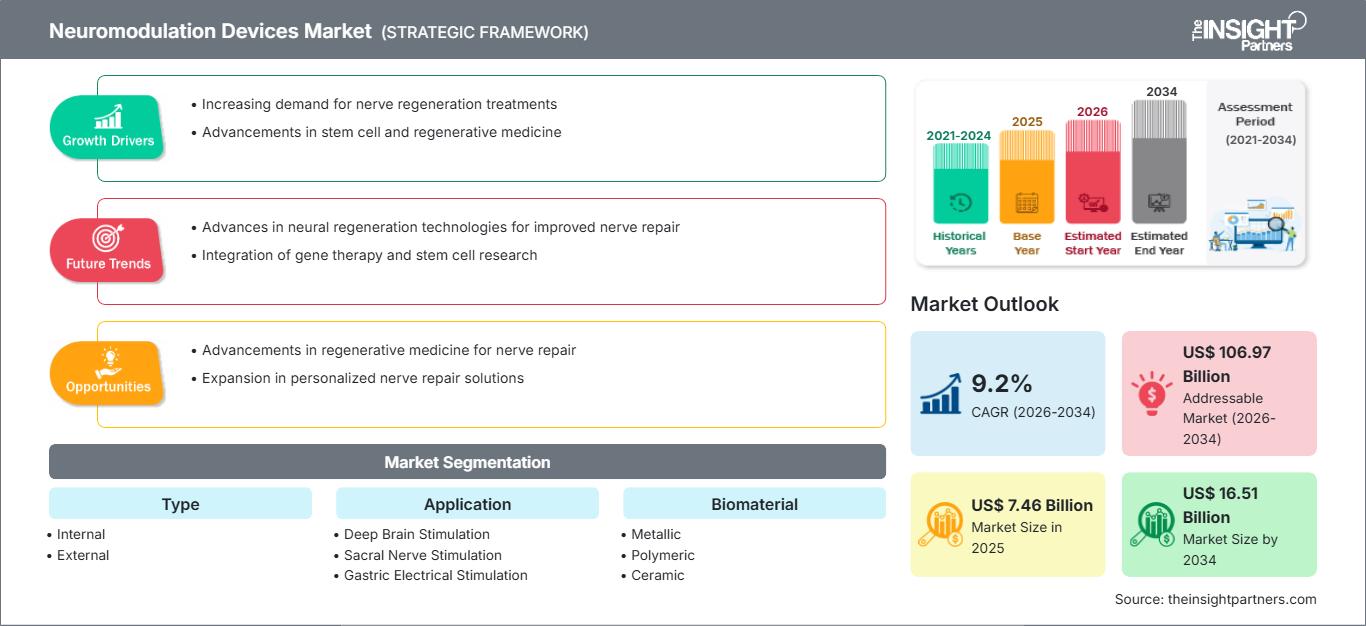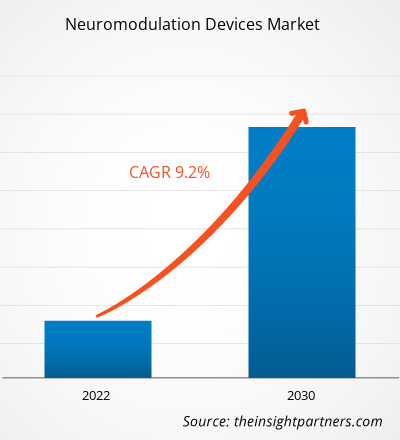Der Markt für Neuromodulationsgeräte, der 2025 einen Wert von 7,46 Milliarden US-Dollar erreichte, wird Prognosen zufolge bis 2034 auf 16,51 Milliarden US-Dollar anwachsen, was einem durchschnittlichen jährlichen Wachstum von 9,2 % im Zeitraum 2026–2034 entspricht. Die Marktbedingungen entwickeln sich stetig weiter und eröffnen den Akteuren neue Chancen. Insgesamt zeichnet sich der Markt durch stabile Fortschritte und langfristiges Wachstumspotenzial aus.
Die Anwendung von Neuromodulation nimmt rasant zu, mit einer breiten Palette implantierbarer und nichtinvasiver Technologien zur Behandlung neuropsychiatrischer und neurologischer Erkrankungen. Therapien wie die intrakranielle kortikale Stimulation (ICS), die transkranielle Magnetstimulation (TMS), die tiefe Hirnstimulation (DBS) und die transkranielle Gleichstromstimulation (tDCS) haben vielversprechende Ergebnisse bei verschiedenen neuropsychiatrischen und neurologischen Erkrankungen gezeigt. Neuromodulationsgeräte sind hochentwickelte medizinische Instrumente, die die Aktivität des Nervensystems modulieren können. Die Technologie wird zur Behandlung von Bewegungsstörungen wie Dystonie, Morbus Parkinson, Tremor, Tinnitus, Zwangsstörungen, sensorischen Beeinträchtigungen, Epilepsie, Blasenfunktionsstörungen, Kopfschmerzen, chronischen Schmerzen, Schlaganfall, Bewusstseinsstörungen, Spastik und Rückenmarksverletzungen eingesetzt. Faktoren wie die steigende Zahl von Rückenmarksverletzungen und die zunehmende Verbreitung neurologischer Erkrankungen tragen zum Wachstum des Marktes für Neuromodulationsgeräte bei.
Markttreiber:
Ältere Menschen sind anfällig für neurologische Erkrankungen. Zu den häufigsten neurologischen Störungen im Alter zählen Neuropathie, Parkinson, Alzheimer, Dystonie und andere. Laut der Abteilung für wirtschaftliche und soziale Angelegenheiten der Vereinten Nationen lebten 2022 weltweit 771 Millionen Menschen im Alter von 65 Jahren und älter. Es wird erwartet, dass die Zahl älterer Menschen bis 2034 auf 994 Millionen und bis 2050 auf 1,6 Milliarden ansteigen wird. In Ländern wie den USA und Kanada ist die Prävalenz von Bewegungsstörungen und psychiatrischen Erkrankungen aufgrund der wachsenden Zahl älterer Menschen hoch. Laut der Parkinson-Stiftung treten Parkinson-Symptome im Durchschnitt ab dem 60. Lebensjahr auf.
Die Canadian Psychological Association gibt an, dass Zwangsstörungen etwa 2 % der kanadischen Bevölkerung betreffen. Die Weltgesundheitsorganisation (WHO) erklärt, dass Epilepsie eine neurologische Erkrankung ist, die Anfälle auslöst und weltweit etwa 50 Millionen Menschen betrifft. Laut der American Academy of Neurology ist Schlaganfall die dritthäufigste Todesursache in den USA, gefolgt von Alzheimer als sechsthäufigster Todesursache. Statistiken derselben Quelle zeigen, dass fast eine Million Amerikaner an Parkinson leiden und jährlich mindestens 60.000 neue Fälle gemeldet werden. Die zunehmende Verbreitung neurologischer Erkrankungen in Verbindung mit lebensstilbedingten Störungen wie Depressionen und chronischen Schmerzen führt zu einer verstärkten Nutzung technologisch fortschrittlicher Produkte.
Daher treiben die steigende Zahl älterer Menschen, die anfällig für neurologische Erkrankungen sind, die zunehmende Verbreitung dieser Krankheiten und das wachsende Bewusstsein für die enorme Belastung durch neurologische Störungen das Wachstum des Marktes für Neuromodulationsgeräte an.
Die Neurowissenschaften konzentrieren sich auf die Behandlung von Erkrankungen wie Schlaganfall, Kopfschmerzerkrankungen, Multipler Sklerose und anderen schweren Fällen. In den letzten Jahren ist selbst in Industrieländern ein relativer Mangel an qualifizierten Neurologen zu beobachten. In den USA gibt es zwar über 5.700 Krankenhäuser, aber weniger als 3.700 Neurochirurgen. Ein wesentlicher Grund für diesen Mangel ist die unzureichende Ausbildung von Neurochirurgen innerhalb eines angemessenen Zeitraums. Neurologische Einrichtungen mit moderner Technologie sind in städtischen Gebieten vorhanden. In ländlichen Gebieten hingegen ist das Behandlungsangebot aufgrund des Fachkräftemangels begrenzt. Daher hemmt der Mangel an qualifizierten Neurochirurgen das Wachstum des Marktes für Neuromodulationsgeräte.
Passen Sie diesen Bericht Ihren Anforderungen an.
Sie erhalten eine kostenlose Anpassung aller Berichte – einschließlich Teilen dieses Berichts, Länderanalysen und Excel-Datenpaketen – sowie attraktive Angebote und Rabatte für Start-ups und Universitäten.
Markt für Neuromodulationsgeräte: Strategische Einblicke

-
Ermitteln Sie die wichtigsten Markttrends dieses Berichts.Diese KOSTENLOSE Probe beinhaltet eine Datenanalyse, die von Markttrends bis hin zu Schätzungen und Prognosen reicht.
Berichtssegmentierung und -umfang:
Die Marktanalyse für Neuromodulationsgeräte wurde unter Berücksichtigung der Segmente Typ, Anwendung, Biomaterial und Endnutzer durchgeführt.
Segmentanalyse:
Der Markt für Neuromodulationsgeräte ist nach Gerätetyp in externe und interne Geräte unterteilt. Das Segment der internen Neuromodulation hatte 2022 den größeren Marktanteil. Es wird jedoch erwartet, dass das Segment der externen Neuromodulation im Zeitraum 2022–2030 eine höhere durchschnittliche jährliche Wachstumsrate (CAGR) verzeichnen wird. Der Begriff „interne Neuromodulation“ beschreibt die Anwendung von Medizinprodukten, die elektrische, chemische oder andere Stimulationsformen für spezifische neuronale Zielstrukturen bereitstellen, um die Aktivität des Nervensystems zu modulieren oder zu verändern. Diese Technik wird zur Behandlung von neurovaskulären Erkrankungen, Bewegungsstörungen, Epilepsie, chronischen Schmerzen sowie Stuhl- und Harninkontinenz eingesetzt.
Der Markt für Neuromodulationsgeräte ist nach Endnutzer in Krankenhäuser, Kliniken und häusliche Pflege unterteilt. Im Jahr 2022 dominierte das Segment der Krankenhäuser den Marktanteil. Aufgrund des Ausbaus zahlreicher Krankenhäuser und Kliniken sowie erhöhter staatlicher Investitionen in den Ausbau der Gesundheitsinfrastruktur ist das Segment der Krankenhäuser derzeit marktführend. Darüber hinaus wird erwartet, dass die alternde Bevölkerung zu einer höheren Prävalenz chronischer Schmerzen führen und damit die Nachfrage nach Neuromodulationsgeräten in Krankenhäusern weiter ankurbeln wird.
Regionalanalyse:
Der Umfang des Marktberichts über Neuromodulationsgeräte ist primär in Nordamerika (USA, Kanada und Mexiko), Europa (Spanien, Großbritannien, Deutschland, Frankreich, Italien und das übrige Europa), Asien-Pazifik (Südkorea, China, Indien, Japan, Australien und das übrige Asien-Pazifik), Naher Osten und Afrika (Südafrika, Saudi-Arabien, die VAE und der übrige Nahe Osten und Afrika) sowie Süd- und Mittelamerika (Brasilien, Argentinien und das übrige Süd- und Mittelamerika) unterteilt.
Nordamerika dominierte 2022 den Markt für Neuromodulationsgeräte hinsichtlich des Umsatzes. Die zunehmende Verbreitung neurologischer Erkrankungen, hohe Ausgaben für Forschung und Entwicklung, eine steigende Anzahl von Produktzulassungen durch die FDA und technologische Fortschritte steigern die Nachfrage nach Neuromodulationsgeräten in der Region.
Neuromodulationsgeräte
Markt für Neuromodulationsgeräte – Regionale Einblicke
Die regionalen Trends und Einflussfaktoren auf den Markt für Neuromodulationsgeräte im gesamten Prognosezeitraum wurden von den Analysten von The Insight Partners eingehend erläutert. Dieser Abschnitt behandelt außerdem die Marktsegmente und die geografische Verteilung des Marktes für Neuromodulationsgeräte in Nordamerika, Europa, Asien-Pazifik, dem Nahen Osten und Afrika sowie Süd- und Mittelamerika.
Berichtsumfang zum Markt für Neuromodulationsgeräte
| Berichtattribute | Details |
|---|---|
| Marktgröße im Jahr 2025 | 7,46 Milliarden US-Dollar |
| Marktgröße bis 2034 | 16,51 Milliarden US-Dollar |
| Globale durchschnittliche jährliche Wachstumsrate (2026 - 2034) | 9,2 % |
| Historische Daten | 2021-2024 |
| Prognosezeitraum | 2026–2034 |
| Abgedeckte Segmente |
Nach Typ
|
| Abgedeckte Regionen und Länder |
Nordamerika
|
| Marktführer und wichtige Unternehmensprofile |
|
Marktdichte der Akteure im Bereich Neuromodulationsgeräte: Auswirkungen auf die Geschäftsdynamik verstehen
Der Markt für Neuromodulationsgeräte wächst rasant, angetrieben durch die steigende Nachfrage der Endverbraucher. Gründe hierfür sind unter anderem sich wandelnde Verbraucherpräferenzen, technologische Fortschritte und ein wachsendes Bewusstsein für die Vorteile der Produkte. Mit steigender Nachfrage erweitern Unternehmen ihr Angebot, entwickeln innovative Lösungen, um den Kundenbedürfnissen gerecht zu werden, und nutzen neue Trends, was das Marktwachstum zusätzlich beflügelt.

- Verschaffen Sie sich einen Überblick über die wichtigsten Akteure auf dem Markt für Neuromodulationsgeräte.
Wettbewerbsumfeld und Schlüsselunternehmen:
Der Marktbericht für Neuromodulationsgeräte konzentriert sich auf führende Marktteilnehmer wie Abbott (St. Jude Medical, Inc.), LivaNova PLC, Boston Scientific Corporation, Aleva Neurotherapeutics SA, Bioventus, EnteroMedics Inc., Nevro Corporation, NeuroPace Inc., Synapse Biomedical Inc. und Neurosigma Inc. Die Marktprognose für Neuromodulationsgeräte unterstützt die Akteure bei der Planung ihrer Wachstumsstrategien. Diese Unternehmen konzentrieren sich auf neue Technologien, die Verbesserung bestehender Produkte und die Marktexpansion, um die weltweit steigende Kundennachfrage zu decken. Laut Unternehmensmitteilungen gab es in letzter Zeit einige wichtige Entwicklungen:
- Im August 2023 erhielt Medtronic plc die CE-Kennzeichnung für seinen wiederaufladbaren, geschlossenen Rückenmarkstimulator (SCS) Inceptiv. Es ist das erste SCS-Gerät von Medtronic mit einer solchen Regelungsfunktion, die die individuellen biologischen Signale jedes Nutzers erfasst und die Stimulation bedarfsgerecht anpasst, um die Therapie optimal mit den Bewegungen des Alltags zu harmonieren.
- Im August 2023 erhielt Abbott von der US-amerikanischen Arzneimittelbehörde FDA die Zulassung für sein neues Rückenmarkstimulationssystem Proclaim Plus mit FlexBurst360-Therapie. Die FlexBurst360-Therapie, die nächste Generation der von Abbott entwickelten BurstDR-Stimulation, bietet Schmerzlinderung in sechs Bereichen des Rumpfes und/oder der Gliedmaßen. Sie ermöglicht eine individuell anpassbare Programmierung.
- Historische Analyse (2 Jahre), Basisjahr, Prognose (7 Jahre) mit CAGR
- PEST- und SWOT-Analyse
- Marktgröße Wert/Volumen – Global, Regional, Land
- Branchen- und Wettbewerbslandschaft
- Excel-Datensatz
Aktuelle Berichte
Erfahrungsberichte
Grund zum Kauf
- Fundierte Entscheidungsfindung
- Marktdynamik verstehen
- Wettbewerbsanalyse
- Kundeneinblicke
- Marktprognosen
- Risikominimierung
- Strategische Planung
- Investitionsbegründung
- Identifizierung neuer Märkte
- Verbesserung von Marketingstrategien
- Steigerung der Betriebseffizienz
- Anpassung an regulatorische Trends






















 Kostenlose Probe anfordern für - Markt für Neuromodulationsgeräte
Kostenlose Probe anfordern für - Markt für Neuromodulationsgeräte